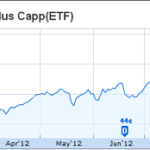The U.S. Equity markets are rocking this year. Up 15.04% after dividends the S&P 500 index (SPY) is on track for one of its best years since 2009. Not all investors are taking part in the upside, however.
Traditional asset allocation leaves some target date funds out of the running for excellent market performance.

Are target date funds outdated?
Target date funds are a fairly new invention on Wall Street, but their investment methods may be outdated. Let’s look at the S&P Target Date 2040 (TZV) from iShares. The product is designed for investors who wish to retire in 2040.
We can assume that if the average knowledgeable investor retires at 59-65, the fund is built for someone who is 32-38 years of age. These investors have one thing in common: a desire to retire in 27 years.
So what’s in the fund? A bunch of underperforming assets.
The iShares fund holds a majority of assets in the United States, with 37.74% of AUM invested in iShares Core S&P 500 ETF (IVV), while another 21.73% is invested exclusively outside the U.S. in the iShares MSCI EAFE Index Fund (EFA), which excludes American and Canadian securities.
Naturally, the laggard here is the international mix of securities. The United States and Canada have some of the strongest economies around the world, with European nations still facing recession. The EU as a whole reports negative economic growth while struggling EU countries face new debt downgrades.
Asia sustains slower, but positive, economic growth.
The fund kicks up the performance by holding more than 9% of assets in American small and midcap ETFs. Small and midcap stocks have outperformed the broad market averages, but I believe the fund is irresponsibly underweight small to midcap stocks, as well as American equities.
American markets aren’t purely-American
Investing internationally was more important in the 1980s than it is in 2013. The reality is that American businesses are not pure-plays on the American economy. Sure, companies like Target (TGT) and Home Depot (HD) may derive all of their revenue and profits in the United States and Canada, but most large cap names derive a significant portion of income overseas.
Take Apple (AAPL), for instance, which sells phones, tablets, and notebooks all over the world. Microsoft (MSFT) has an international story, as do payment processors like Visa (V), or soda-sellers like Coca-Cola (KO). Even completely foreign companies like Philip Morris International (PM) choose to list on American markets. Philip Morris International is an S&P 500 component despite the fact that it does not make a dime in American markets.
Only 46.1% of revenue reported by S&P 500 firms came from the United States in 2011, according to research from Standard & Poor’s. The “All-American†index that is the S&P 500 is, in fact, anything but American. Apple pie this index is not.
So while target date funds may keep the S&P 500 as their largest holding, they may still be underweight American companies.
Looking under the hood
My goal isn’t to push investors from target date funds. The products are cheap, certainly less expensive than most actively-managed funds. Furthermore, target date funds are making up more and more of the choices inside employer-sponsored retirement accounts like 401ks. These are certainly better products than the alternative (expensive mutual funds loaded with commissions), but hardly set-and-forget investment products.
If you’re heavily invested in target date funds, it’s time to look at what you own and make sure it fits your risk-profile. Frankly, I’m astonished that a 2040 fund would invest such a small amount in fixed-income (4% of AUM is meaningless) and weight so heavily large cap stocks when those who hold it have 27 years to retirement.
You can easily “update†your target date fund by duplicating a fund to your liking. A number of brokerage houses offer commission-free trades on ETFs, which makes it easy to “top off†a target date fund with a separate IRA to rebalance your exposure. Investors should consider cutting their pure-foreign plays and adding to American small and mid caps, which derive significantly more of their revenue and profits from North America.
The S&P 500 is no longer a proxy for the American economy; like the United States, it’s a melting pot of foreign assets. Buyer beware; your target date fund probably doesn’t follow an allocation that you find favorable - and the media often contributes to more misinformation on comparisons and expectations like these gems outlined in Target-Date Shenanigans.











{ 0 comments… add one now }